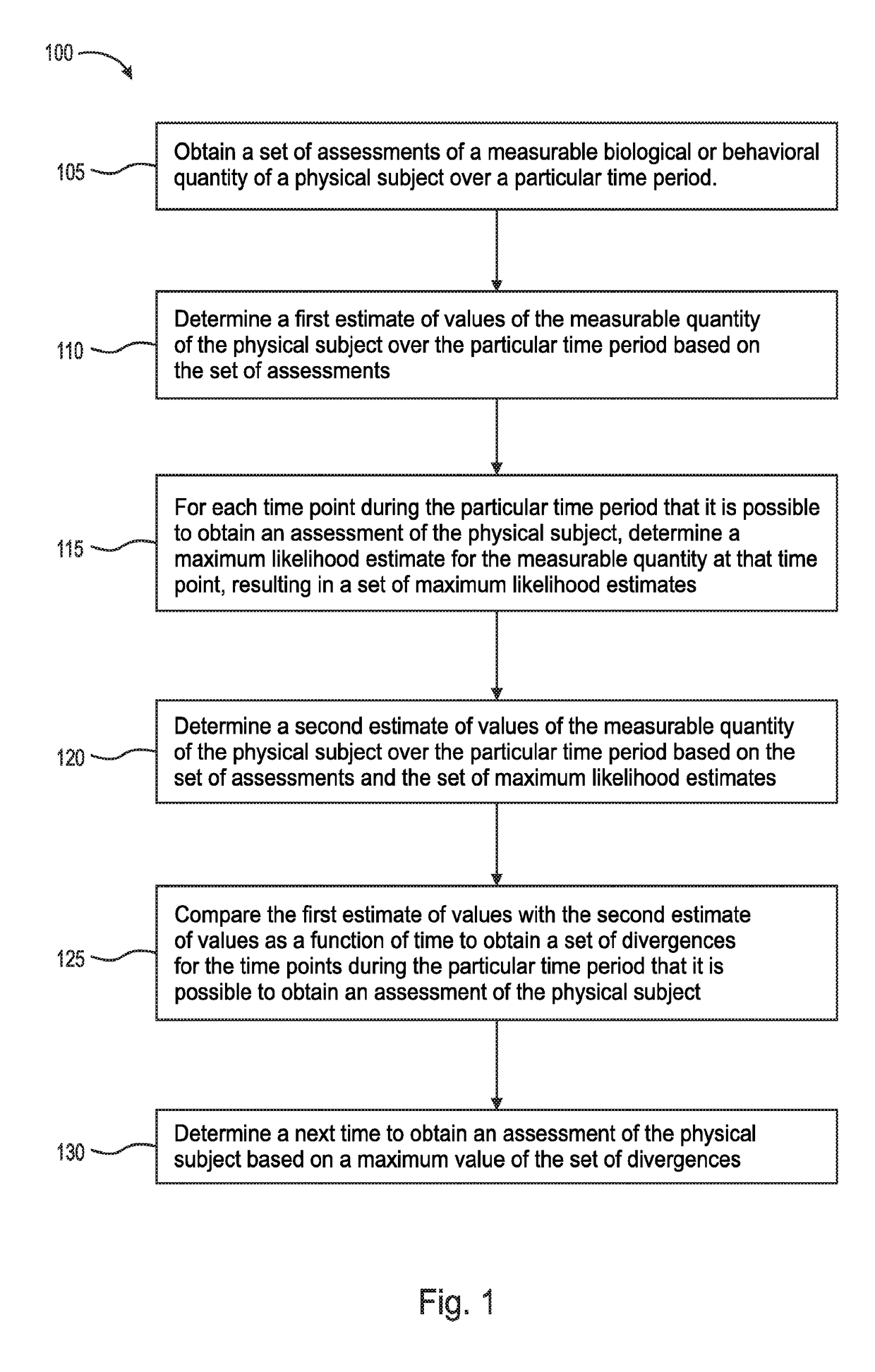Method And System For Adaptive Scheduling Of Clinical Assessments
a clinical assessment and adaptive scheduling technology, applied in the field of clinical assessment adaptive scheduling, can solve the problems of reducing the quality of data, reducing the efficiency of dynamic range of each patient's performance, and limited ema approaches
- Summary
- Abstract
- Description
- Claims
- Application Information
AI Technical Summary
Benefits of technology
Problems solved by technology
Method used
Image
Examples
example 1
n
[0102]The example application of Example 1 determines estimates of an underlying cyclical time series function of the form:
y(t)=α sinc(2πt / N)
t={0,1, . . . ,N}
[0103]where N is the length of one cycle of y(t). The underlying function is unknown. Noisy samples, s(t), are obtained from the function where the samples are normally distributed with SD, σ:
s(t)˜(y(t),σ)
[0104]Samples are obtained from multiple, successive cycles of the function, but for simplicity, all samples are depicted within a single cycle. So that, for example, if a sample at t=50 is selected followed by a sample at t=30, it is understood that the latter sample occurs in the subsequent cycle.
[0105]For this simulation, α=3, N=101, and σ=0.5. The example application begins by collecting eleven equally spaced samples at t={1, 11, . . . , 101}. Optimal samples are then selected for an additional 100 iterations. The results are shown in FIGS. 12A-C. The estimated and true functions are shown in FIG. 12A. The mean-squared er...
example 2
ssure Measurement
[0106]In Example 2, measurements of systolic and diastolic blood pressure for a single subject were collected every 30 minutes over a 24-hour period. The data were used to simulate the operation of the disclosed methods and systems. As above, samples were selected as if from successive cycles of the function, i.e., BP as a function of time. Only one data point per 30-minute time interval was selected. The example application begins by obtaining nine samples: every 3 hours from 0:00 to 21:00, and then one sample at 23:30. It then selects optimal sample times until all of the data have been sampled. The results are shown in FIGS. 13A-C. FIG. 13B shows the MSE of the function estimates made at each iteration with respect to the full data set. A low asymptote is approached at 16 iterations, a total of 25 samples over eight cycles (i.e., 24-hour periods) of the function. The function estimates after 16 iterations are shown in FIG. 13A with estimates derived from the full...
example 3
Drug Treatment for Macular Degeneration
[0107]In Example 3, data was collected from twenty subjects who were receiving treatment for macular degeneration in the form of injections of anti vascular endothelial growth factor (antiVEGF). Following the injections, periodic tests were carried out (approximately once every two days over a 90-day period) to measure the effectiveness of the drug in improving the subjects' vision. For the purposes Example 3, one of these tests is shown, the contrast sensitivity function (CSF), which measures the ability of a subject to reliably identify a stimulus (e.g., a letter on a standard vision chart) as a function of its contrast and spatial frequency (i.e., size). Sensitivity is quantified using a standard summary statistic, the area under the log CSF (AULCSF). Each subject's AULCSF is normalized with respect to his or her maximum measured value. All subjects' data are then combined resulting in a set containing measurements at a rate of approximately...
PUM
 Login to View More
Login to View More Abstract
Description
Claims
Application Information
 Login to View More
Login to View More - R&D
- Intellectual Property
- Life Sciences
- Materials
- Tech Scout
- Unparalleled Data Quality
- Higher Quality Content
- 60% Fewer Hallucinations
Browse by: Latest US Patents, China's latest patents, Technical Efficacy Thesaurus, Application Domain, Technology Topic, Popular Technical Reports.
© 2025 PatSnap. All rights reserved.Legal|Privacy policy|Modern Slavery Act Transparency Statement|Sitemap|About US| Contact US: help@patsnap.com



